
RobertoFeuda
@robertofeuda.bsky.social
Associate Professor at the Univerisity of Bologna. Past Maynooth, Oxford, Caltech, Bristol, Leicester and URF Webpage: https://sites.google.com/view/feudalab/home?authuser=0
Pinned

Monoaminergic neurons share transcriptional identity across Bilaterian animals
The evolutionary conservation of cell types over deep time has long been theorised but remains difficult to demonstrate. Monoaminergic neurons, which produce molecules such as serotonin and dopamine, ...
www.biorxiv.org
A productive month for the lab — between new preprints and papers!
Monoaminergic neurons evo and devo www.biorxiv.org/content/10.1...
www.biorxiv.org/content/10.1...
Opsin evolution in plankton
academic.oup.com/gbe/article/...
Mosquito Cell Atlas (small contrib.)
www.cell.com/cell/fulltex...
Monoaminergic neurons evo and devo www.biorxiv.org/content/10.1...
www.biorxiv.org/content/10.1...
Opsin evolution in plankton
academic.oup.com/gbe/article/...
Mosquito Cell Atlas (small contrib.)
www.cell.com/cell/fulltex...
Reposted by RobertoFeuda
Working in a biomed institute, its natural to think about health & medical impact of dev bio but there's more to dev bio
Agriculture is dev bio (plant growth, livestock breeding)
And dev bio is important to understand environment & climate impact. See e.g:
journals.biologists.com/dev/article/...
Agriculture is dev bio (plant growth, livestock breeding)
And dev bio is important to understand environment & climate impact. See e.g:
journals.biologists.com/dev/article/...

In preprints: multiomics of low temperature acclimation in the era of intensifying temperature fluctuations
In a warming world, all life forms – endotherms and ectotherms alike – are finding their homeostasis being challenged. The environmental change is challenging at all stages of life. How different orga...
journals.biologists.com
November 5, 2025 at 12:33 PM
Working in a biomed institute, its natural to think about health & medical impact of dev bio but there's more to dev bio
Agriculture is dev bio (plant growth, livestock breeding)
And dev bio is important to understand environment & climate impact. See e.g:
journals.biologists.com/dev/article/...
Agriculture is dev bio (plant growth, livestock breeding)
And dev bio is important to understand environment & climate impact. See e.g:
journals.biologists.com/dev/article/...
A productive month for the lab — between new preprints and papers!
Monoaminergic neurons evo and devo www.biorxiv.org/content/10.1...
www.biorxiv.org/content/10.1...
Opsin evolution in plankton
academic.oup.com/gbe/article/...
Mosquito Cell Atlas (small contrib.)
www.cell.com/cell/fulltex...
Monoaminergic neurons evo and devo www.biorxiv.org/content/10.1...
www.biorxiv.org/content/10.1...
Opsin evolution in plankton
academic.oup.com/gbe/article/...
Mosquito Cell Atlas (small contrib.)
www.cell.com/cell/fulltex...

Monoaminergic neurons share transcriptional identity across Bilaterian animals
The evolutionary conservation of cell types over deep time has long been theorised but remains difficult to demonstrate. Monoaminergic neurons, which produce molecules such as serotonin and dopamine, ...
www.biorxiv.org
November 4, 2025 at 1:43 PM
A productive month for the lab — between new preprints and papers!
Monoaminergic neurons evo and devo www.biorxiv.org/content/10.1...
www.biorxiv.org/content/10.1...
Opsin evolution in plankton
academic.oup.com/gbe/article/...
Mosquito Cell Atlas (small contrib.)
www.cell.com/cell/fulltex...
Monoaminergic neurons evo and devo www.biorxiv.org/content/10.1...
www.biorxiv.org/content/10.1...
Opsin evolution in plankton
academic.oup.com/gbe/article/...
Mosquito Cell Atlas (small contrib.)
www.cell.com/cell/fulltex...
Reposted by RobertoFeuda
Excited to announce the final version of the Mosquito Cell Atlas is out now in @cellpress.bsky.social!! 🦟🩸
There is SO much left to find & investigate in this dataset (& the rich biology of the Aedes aegypti mosquito)! We hope this helps scientists in many fields!
www.cell.com/cell/fulltex...
There is SO much left to find & investigate in this dataset (& the rich biology of the Aedes aegypti mosquito)! We hope this helps scientists in many fields!
www.cell.com/cell/fulltex...

A single-nucleus transcriptomic atlas of the adult Aedes aegypti mosquito
A comprehensive single-nucleus RNA-seq atlas of >367,000 nuclei from male and female
Aedes aegypti mosquitoes reveals sexual dimorphism in sensory systems and brain cell
types and widespread co-expres...
www.cell.com
October 30, 2025 at 4:05 PM
Excited to announce the final version of the Mosquito Cell Atlas is out now in @cellpress.bsky.social!! 🦟🩸
There is SO much left to find & investigate in this dataset (& the rich biology of the Aedes aegypti mosquito)! We hope this helps scientists in many fields!
www.cell.com/cell/fulltex...
There is SO much left to find & investigate in this dataset (& the rich biology of the Aedes aegypti mosquito)! We hope this helps scientists in many fields!
www.cell.com/cell/fulltex...
New preprint out! Evolutionarily conserved transcriptional regulators control monoaminergic neuron development.
We uncover how ancient regulatory programs orchestrate the neurons that produce serotonin and dopamine across 550 million years of evolution.
doi.org/10.1101/2025...
We uncover how ancient regulatory programs orchestrate the neurons that produce serotonin and dopamine across 550 million years of evolution.
doi.org/10.1101/2025...

Evolutionarily conserved transcriptional regulators control monoaminergic neuron development
To what extent conserved developmental programs specify homologous cell types is a central question in biology. Here, we address this by focusing on reconstructing monoaminergic neuron development in ...
doi.org
October 30, 2025 at 9:42 AM
New preprint out! Evolutionarily conserved transcriptional regulators control monoaminergic neuron development.
We uncover how ancient regulatory programs orchestrate the neurons that produce serotonin and dopamine across 550 million years of evolution.
doi.org/10.1101/2025...
We uncover how ancient regulatory programs orchestrate the neurons that produce serotonin and dopamine across 550 million years of evolution.
doi.org/10.1101/2025...
Reposted by RobertoFeuda
Come join the #LondonEvoDevo network half day meeting, hosted at @ucl.ac.uk on Friday November 7th, 2025. Submit your abstract by Oct 27th (or your interest in joining) here: forms.gle/TRbdrCkQTcY2.... Friendly vibes and free registration. More info here: londonevodevo.co.uk.

LondonEvoDevo
meeting's website
londonevodevo.co.uk
October 20, 2025 at 1:42 PM
Come join the #LondonEvoDevo network half day meeting, hosted at @ucl.ac.uk on Friday November 7th, 2025. Submit your abstract by Oct 27th (or your interest in joining) here: forms.gle/TRbdrCkQTcY2.... Friendly vibes and free registration. More info here: londonevodevo.co.uk.
We have a fully funded PhD to study mosquito vision — combining single-cell genomics, evolutionary genomics & high-resolution imaging.
Discover how these tiny hunters see the world.
RP, apply and contact me if interested! warwick.ac.uk/fac/cross_fa...
Discover how these tiny hunters see the world.
RP, apply and contact me if interested! warwick.ac.uk/fac/cross_fa...
Dr Roberto Feuda
Dr Roberto Feuda
warwick.ac.uk
October 17, 2025 at 9:56 AM
We have a fully funded PhD to study mosquito vision — combining single-cell genomics, evolutionary genomics & high-resolution imaging.
Discover how these tiny hunters see the world.
RP, apply and contact me if interested! warwick.ac.uk/fac/cross_fa...
Discover how these tiny hunters see the world.
RP, apply and contact me if interested! warwick.ac.uk/fac/cross_fa...
Reposted by RobertoFeuda
The version of record of our paper on the emergence of metachronal waves in the #platynereis larval ciliary band is now out. Together with Rebecca Poon and Kirsty Wan @micromotility.bsky.social
https://www.science.org/doi/10.1126/sciadv.adw4067
funded by
@ERC_Research @wellcometrust @bbsrc
https://www.science.org/doi/10.1126/sciadv.adw4067
funded by
@ERC_Research @wellcometrust @bbsrc
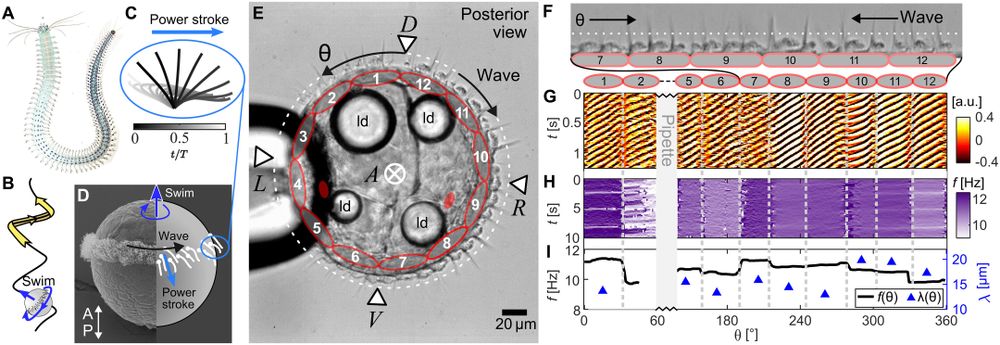
October 16, 2025 at 11:48 AM
The version of record of our paper on the emergence of metachronal waves in the #platynereis larval ciliary band is now out. Together with Rebecca Poon and Kirsty Wan @micromotility.bsky.social
https://www.science.org/doi/10.1126/sciadv.adw4067
funded by
@ERC_Research @wellcometrust @bbsrc
https://www.science.org/doi/10.1126/sciadv.adw4067
funded by
@ERC_Research @wellcometrust @bbsrc
Reposted by RobertoFeuda
We are happy to share our latest work in @nature.com . We study the genomic and cellular basis of facultative symbiosis in Oculina patagonica - a Mediterranean coral remarkable for its ability to survive long periods without algal symbionts. Led by Shani Levy and @xgrau.bsky.social
rdcu.be/eLbaZ
rdcu.be/eLbaZ
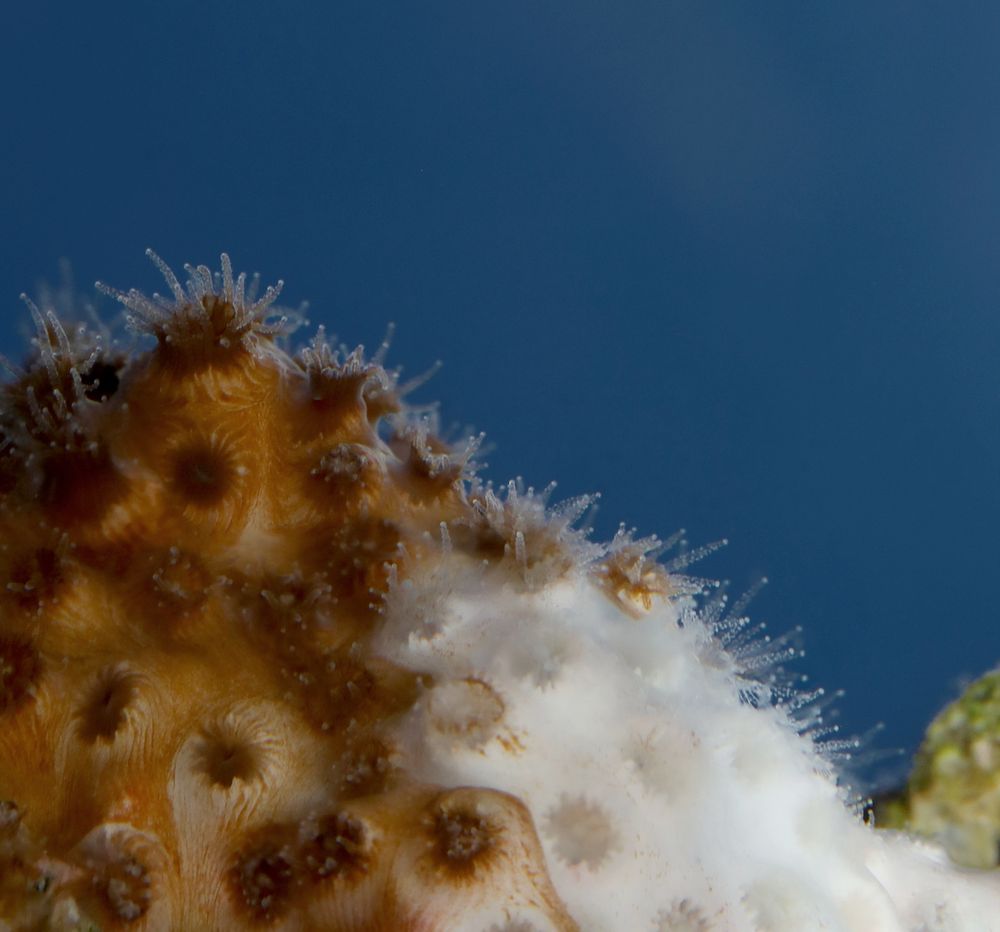
October 15, 2025 at 7:58 PM
We are happy to share our latest work in @nature.com . We study the genomic and cellular basis of facultative symbiosis in Oculina patagonica - a Mediterranean coral remarkable for its ability to survive long periods without algal symbionts. Led by Shani Levy and @xgrau.bsky.social
rdcu.be/eLbaZ
rdcu.be/eLbaZ
Interested in joining my lab to study the evolution and development of monoaminergic neurons?
You can now apply for the Giuseppe Levi Post-Doc Fellowship (2 years, Neurobiology, EU citizens).
Deadline: 10 Nov 2025 – 18:00
For more info selezionionline.lincei.it and email me!
You can now apply for the Giuseppe Levi Post-Doc Fellowship (2 years, Neurobiology, EU citizens).
Deadline: 10 Nov 2025 – 18:00
For more info selezionionline.lincei.it and email me!
Online Applications – Accademia Nazionale dei Lincei
- Home
Online Applications – Accademia Nazionale dei Lincei
selezionionline.lincei.it
October 14, 2025 at 10:43 AM
Interested in joining my lab to study the evolution and development of monoaminergic neurons?
You can now apply for the Giuseppe Levi Post-Doc Fellowship (2 years, Neurobiology, EU citizens).
Deadline: 10 Nov 2025 – 18:00
For more info selezionionline.lincei.it and email me!
You can now apply for the Giuseppe Levi Post-Doc Fellowship (2 years, Neurobiology, EU citizens).
Deadline: 10 Nov 2025 – 18:00
For more info selezionionline.lincei.it and email me!
Reposted by RobertoFeuda
Thrilled to share that the lab has been awarded a @wellcometrust.bsky.social Discovery Award to keep exploring the evolution of 6-methyladenine #6mA in Eukaryotes. We'll open postdoc (3️⃣) and tech (1️⃣) positions to start in 2026, please share with candidates or reach out if you’d like to join us.
October 8, 2025 at 12:17 PM
Thrilled to share that the lab has been awarded a @wellcometrust.bsky.social Discovery Award to keep exploring the evolution of 6-methyladenine #6mA in Eukaryotes. We'll open postdoc (3️⃣) and tech (1️⃣) positions to start in 2026, please share with candidates or reach out if you’d like to join us.
Reposted by RobertoFeuda
The @crick.ac.uk is recruiting Early Career Group Leaders
- Lab set-up, research costs, salaries for up to 5 researchers
- Support for up to 12 years
- Access to our core facilities
- Competitive salary
- Fantastic colleagues
- All areas of biology
Deadline 27 Nov
www.crick.ac.uk/careers-stud...
- Lab set-up, research costs, salaries for up to 5 researchers
- Support for up to 12 years
- Access to our core facilities
- Competitive salary
- Fantastic colleagues
- All areas of biology
Deadline 27 Nov
www.crick.ac.uk/careers-stud...
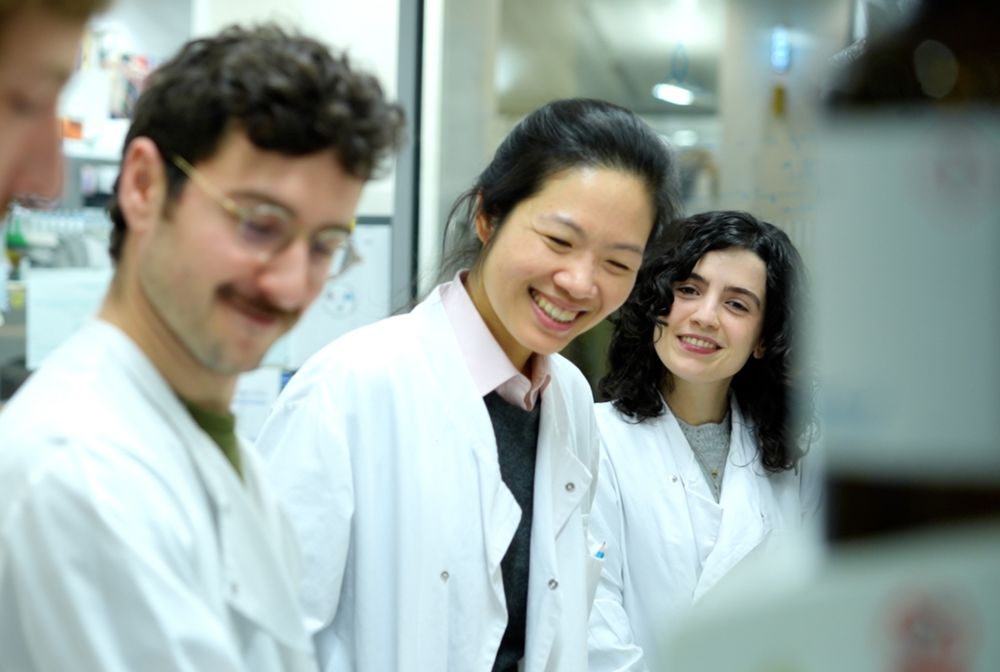
Early career group leaders
We appoint researchers from across biology and biomedicine to set up their first groups at the Crick.
www.crick.ac.uk
October 10, 2025 at 8:20 AM
The @crick.ac.uk is recruiting Early Career Group Leaders
- Lab set-up, research costs, salaries for up to 5 researchers
- Support for up to 12 years
- Access to our core facilities
- Competitive salary
- Fantastic colleagues
- All areas of biology
Deadline 27 Nov
www.crick.ac.uk/careers-stud...
- Lab set-up, research costs, salaries for up to 5 researchers
- Support for up to 12 years
- Access to our core facilities
- Competitive salary
- Fantastic colleagues
- All areas of biology
Deadline 27 Nov
www.crick.ac.uk/careers-stud...
Our latest: combining single-cell RNA-seq from 16 species and HCR validation, we show that monoaminergic neurons share a conserved transcriptional identity across Bilateria. In contrast, we find no evidence for this program in non-bilaterian metazoans. www.biorxiv.org/content/10.1...

Monoaminergic neurons share transcriptional identity across Bilaterian animals
The evolutionary conservation of cell types over deep time has long been theorised but remains difficult to demonstrate. Monoaminergic neurons, which produce molecules such as serotonin and dopamine, ...
www.biorxiv.org
October 10, 2025 at 9:43 PM
Our latest: combining single-cell RNA-seq from 16 species and HCR validation, we show that monoaminergic neurons share a conserved transcriptional identity across Bilateria. In contrast, we find no evidence for this program in non-bilaterian metazoans. www.biorxiv.org/content/10.1...
Reposted by RobertoFeuda
I adored writing this piece. It brings together several of the things preoccupying me right now, like chromatin organization and gene regulation. There's so much more to be said on that. Also, these marine critters look gorgeous.
www.quantamagazine.org/loops-of-dna...
www.quantamagazine.org/loops-of-dna...

Loops of DNA Equipped Ancient Life To Become Complex | Quanta Magazine
New work shows that physical folding of the genome to control genes located far away may have been an early evolutionary development.
www.quantamagazine.org
October 8, 2025 at 2:21 PM
I adored writing this piece. It brings together several of the things preoccupying me right now, like chromatin organization and gene regulation. There's so much more to be said on that. Also, these marine critters look gorgeous.
www.quantamagazine.org/loops-of-dna...
www.quantamagazine.org/loops-of-dna...
Reposted by RobertoFeuda
New short paper from our lab @currentbiology.bsky.social, in which we discover of a new mode of cell motility for choanoflagellates: flagellar gliding. www.cell.com/current-biol... - A 🧵

Flagellar gliding in choanoflagellates
Freire-Delgado and Brunet discover a new mode of cell motility in choanoflagellates,
the closest relatives of animals. Under mild confinement, choanoflagellate move over
surfaces without cell deformat...
www.cell.com
September 9, 2025 at 6:12 PM
New short paper from our lab @currentbiology.bsky.social, in which we discover of a new mode of cell motility for choanoflagellates: flagellar gliding. www.cell.com/current-biol... - A 🧵
Our latest: We optimized SPLiT-Seq for insect brains!
Check out our new protocol in Methods in Molecular Biology—tailored single-cell transcriptomics for insect neuroscience link.springer.com/protocol/10....
Check out our new protocol in Methods in Molecular Biology—tailored single-cell transcriptomics for insect neuroscience link.springer.com/protocol/10....

An Optimized SPLiT-Seq Protocol for Insects
Single-cell RNA-sequencing revolutionized our approach of transcriptomic studies, enabling to analyze gene expression across cell type in a tissue. Here we introduce an optimized cell dissociation and...
link.springer.com
August 22, 2025 at 4:30 PM
Our latest: We optimized SPLiT-Seq for insect brains!
Check out our new protocol in Methods in Molecular Biology—tailored single-cell transcriptomics for insect neuroscience link.springer.com/protocol/10....
Check out our new protocol in Methods in Molecular Biology—tailored single-cell transcriptomics for insect neuroscience link.springer.com/protocol/10....
Reposted by RobertoFeuda
After nearly twenty years in the making, our attempt at understanding what makes the chaetognath phylum so unique has finally been published! www.nature.com/articles/s41...
with #LauraPiovani @dariagavr.bsky.social @alexdemendoza.bsky.social @chemamd.bsky.social and others /1
with #LauraPiovani @dariagavr.bsky.social @alexdemendoza.bsky.social @chemamd.bsky.social and others /1

The genomic origin of the unique chaetognath body plan - Nature
Genomic, single-cell transcriptomic and epigenetic analyses show that chaetognaths, following extensive gene loss in the gnathiferan lineage, relied on newly evolved genes and lineage-specific tandem ...
www.nature.com
August 13, 2025 at 4:38 PM
After nearly twenty years in the making, our attempt at understanding what makes the chaetognath phylum so unique has finally been published! www.nature.com/articles/s41...
with #LauraPiovani @dariagavr.bsky.social @alexdemendoza.bsky.social @chemamd.bsky.social and others /1
with #LauraPiovani @dariagavr.bsky.social @alexdemendoza.bsky.social @chemamd.bsky.social and others /1
Reposted by RobertoFeuda
A Summer reading recommendation: new primer in @dev-journal.bsky.social explains how dynamical systems theory unlocks the logic of developmental patterning
Everything from bistable switches & oscillators to phase portraits & more with Python code to explore
journals.biologists.com/dev/article/...
Everything from bistable switches & oscillators to phase portraits & more with Python code to explore
journals.biologists.com/dev/article/...
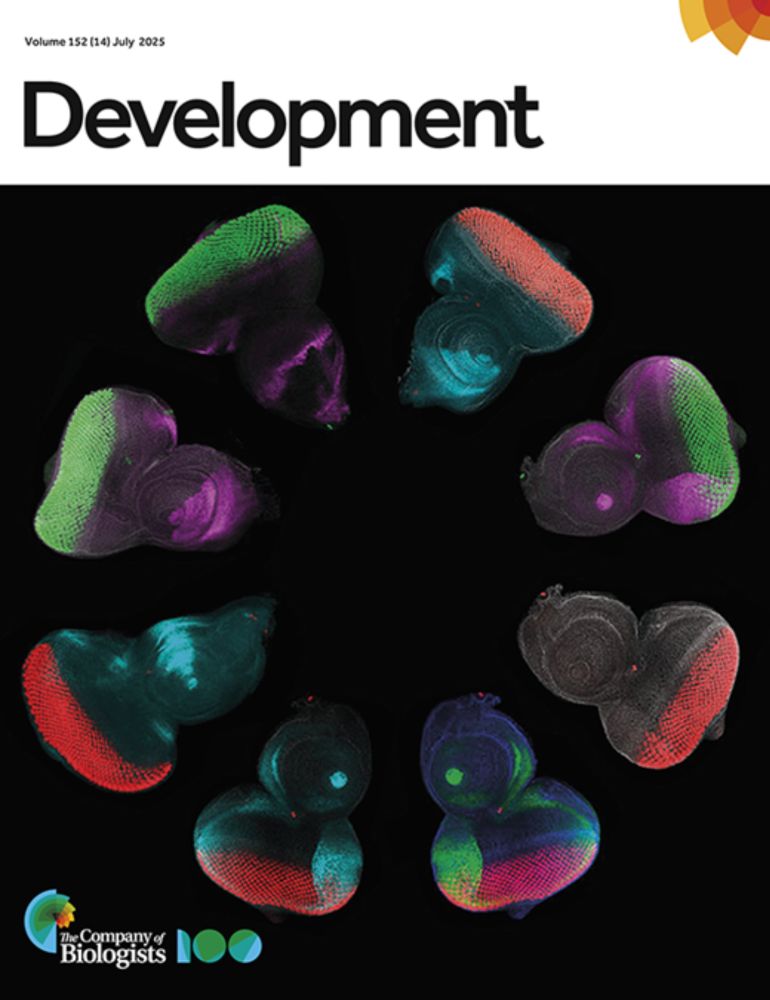
From genes to patterns: five key dynamical systems concepts to decode developmental regulatory mechanisms
Summary: Dynamical systems theory provides a powerful quantitative and intuitive framework to understand developmental processes. This Primer brings key concepts of this framework to the ever-growing ...
journals.biologists.com
August 4, 2025 at 8:44 AM
A Summer reading recommendation: new primer in @dev-journal.bsky.social explains how dynamical systems theory unlocks the logic of developmental patterning
Everything from bistable switches & oscillators to phase portraits & more with Python code to explore
journals.biologists.com/dev/article/...
Everything from bistable switches & oscillators to phase portraits & more with Python code to explore
journals.biologists.com/dev/article/...
Reposted by RobertoFeuda
Happy to see our latest work out in @molbioevol.bsky.social. We revisit the evolution of 5-methylcytosine across neglected eukaryotic supergroups, establishing an ancestral repressive role silencing genome invaders, both transposons and viral elements👾: academic.oup.com/mbe/advance-... 🧵 1/7
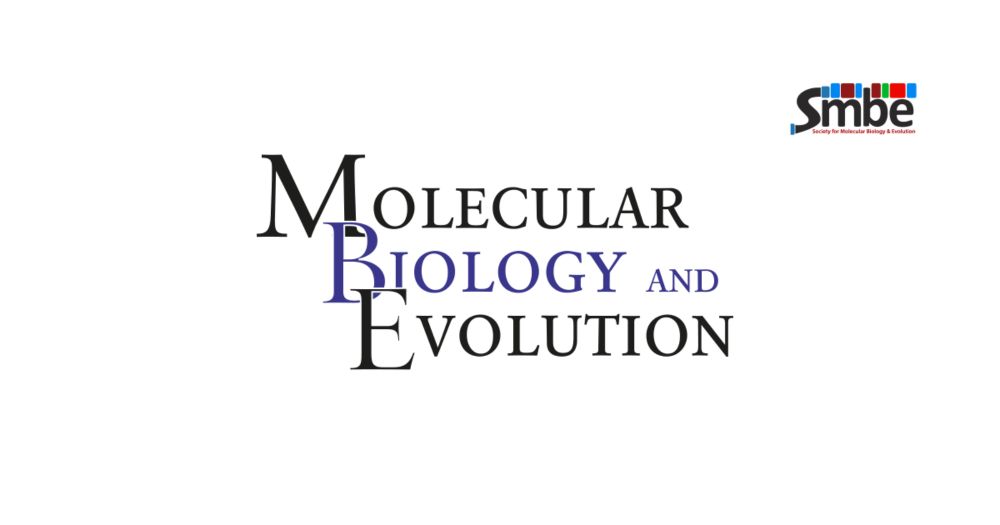
Repressive cytosine methylation is a marker of viral gene transfer across divergent eukaryotes
Abstract. Cytosine DNA methylation patterns vary widely across eukaryotes, with its ancestral roles being understood to have included both transposable ele
academic.oup.com
July 28, 2025 at 10:03 AM
Happy to see our latest work out in @molbioevol.bsky.social. We revisit the evolution of 5-methylcytosine across neglected eukaryotic supergroups, establishing an ancestral repressive role silencing genome invaders, both transposons and viral elements👾: academic.oup.com/mbe/advance-... 🧵 1/7
Reposted by RobertoFeuda
✨Animal evolution fans, rejoice! CRISPR-Cas9 is now in Corallochytrium ready to unlock secrets of animal origins! 🔬Led by @patriciasuarez.bsky.social & @sebasn1.bsky.social
royalsocietypublishing.org/doi/10.1098/... @royalsociety.org @ibe-barcelona.bsky.social#holozoans #ProtistsonSky
royalsocietypublishing.org/doi/10.1098/... @royalsociety.org @ibe-barcelona.bsky.social#holozoans #ProtistsonSky
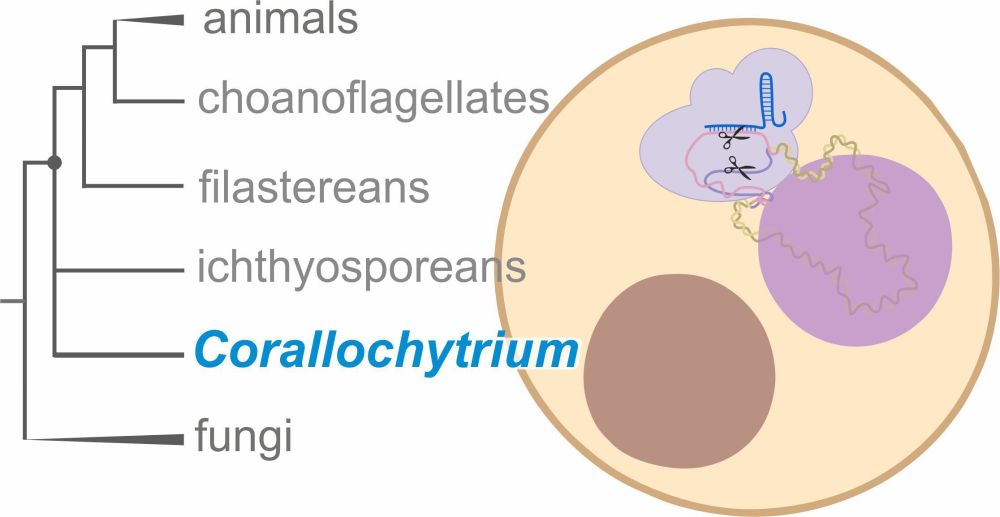
CRISPR-Cas9 genome editing in Corallochytrium limacisporum,a key species for understanding animal origins | Open Biology
Microbial holozoans are the closest unicellular relatives of animals. They share a
substantial gene repertoire with animals and exhibit complex life cycles. Studying
these organisms is crucial for und...
royalsocietypublishing.org
July 28, 2025 at 7:35 AM
✨Animal evolution fans, rejoice! CRISPR-Cas9 is now in Corallochytrium ready to unlock secrets of animal origins! 🔬Led by @patriciasuarez.bsky.social & @sebasn1.bsky.social
royalsocietypublishing.org/doi/10.1098/... @royalsociety.org @ibe-barcelona.bsky.social#holozoans #ProtistsonSky
royalsocietypublishing.org/doi/10.1098/... @royalsociety.org @ibe-barcelona.bsky.social#holozoans #ProtistsonSky
Reposted by RobertoFeuda
Ireland launches global talent fund! www.researchireland.ie/funding/glob...
If you're a neuroscience professor (assistant/associate/full) and would consider relocating to the vibrant and booming city of Dublin, please get in touch!
If you're a neuroscience professor (assistant/associate/full) and would consider relocating to the vibrant and booming city of Dublin, please get in touch!

July 19, 2025 at 8:20 AM
Ireland launches global talent fund! www.researchireland.ie/funding/glob...
If you're a neuroscience professor (assistant/associate/full) and would consider relocating to the vibrant and booming city of Dublin, please get in touch!
If you're a neuroscience professor (assistant/associate/full) and would consider relocating to the vibrant and booming city of Dublin, please get in touch!
Reposted by RobertoFeuda
We are looking for new colleagues to come join us in Galway as group leaders (Junior and Senior). The Centre for Chromosome Biology is a great place and it is a good time to join. Please reach out if you want to chat about the opportunity!
www.nature.com/naturecareer...
www.nature.com/naturecareer...
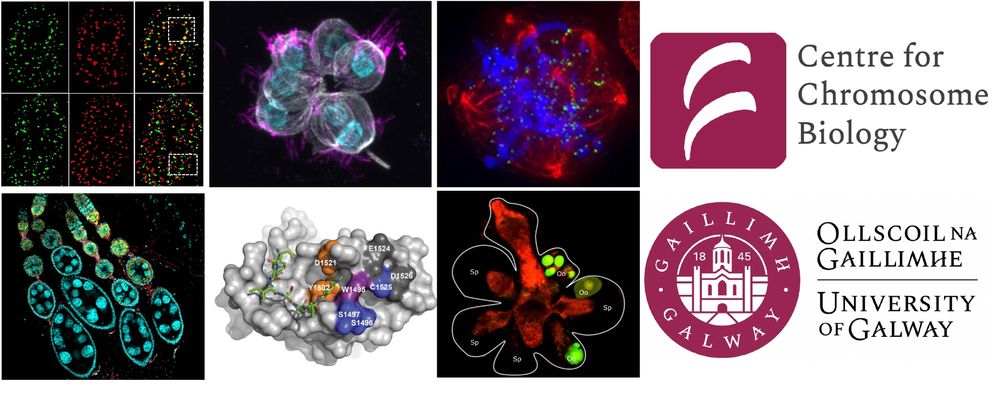
July 16, 2025 at 8:56 AM
We are looking for new colleagues to come join us in Galway as group leaders (Junior and Senior). The Centre for Chromosome Biology is a great place and it is a good time to join. Please reach out if you want to chat about the opportunity!
www.nature.com/naturecareer...
www.nature.com/naturecareer...
Reposted by RobertoFeuda
Neuron programming! Pro-neural TFs + 480 morphogen conditions + scRNA-seq --> Diverse iN subtypes of forebrain, midbrain, hindbrain, spinal cord, and PNS. @hsiuchuanlin.bsky.social @jasperjanssens.bsky.social and Treutlein Lab! @science.org www.science.org/doi/10.1126/... #NGN2 #ASCL1
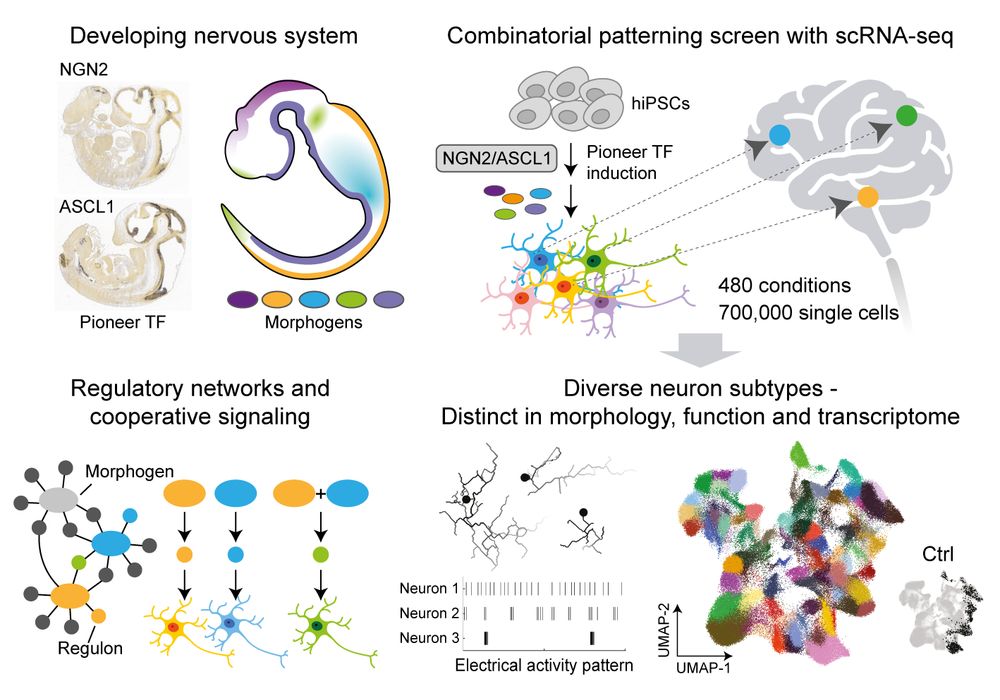
July 11, 2025 at 8:59 PM
Neuron programming! Pro-neural TFs + 480 morphogen conditions + scRNA-seq --> Diverse iN subtypes of forebrain, midbrain, hindbrain, spinal cord, and PNS. @hsiuchuanlin.bsky.social @jasperjanssens.bsky.social and Treutlein Lab! @science.org www.science.org/doi/10.1126/... #NGN2 #ASCL1
Reposted by RobertoFeuda
Can using synthetic approaches to build biology help teach us the design principles of how embryos build themselves? 👷♀️🔧
If this is a question that interests you, come and share your thoughts at this Royal Society Workshop on Generative Biology
royalsociety.org/science-even...
If this is a question that interests you, come and share your thoughts at this Royal Society Workshop on Generative Biology
royalsociety.org/science-even...
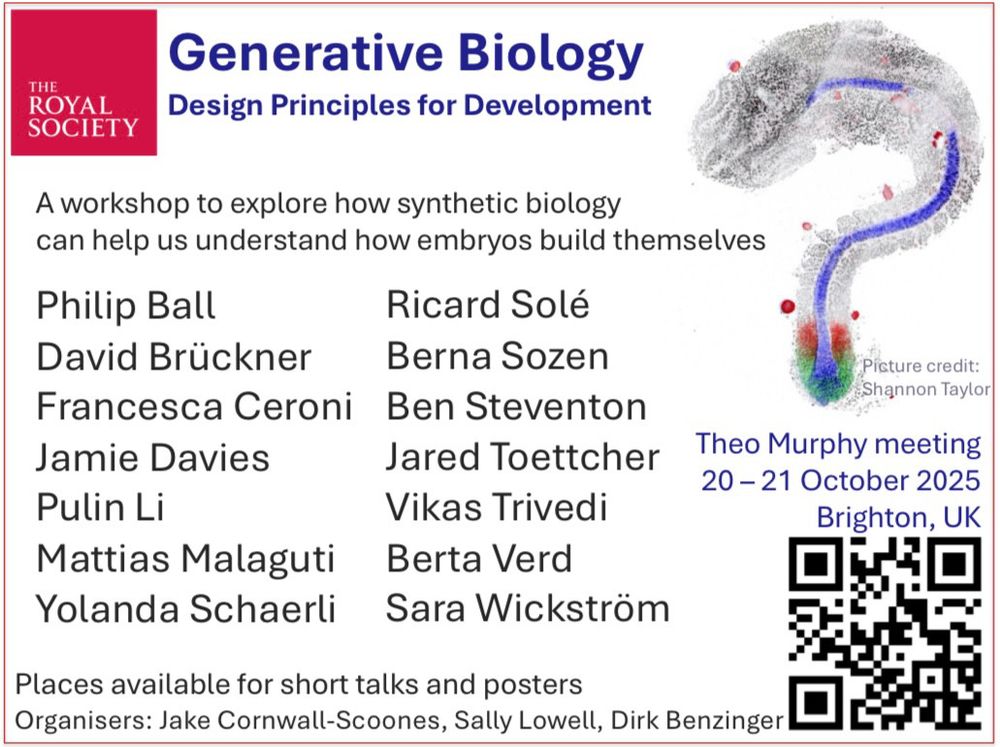
July 3, 2025 at 4:26 PM
Can using synthetic approaches to build biology help teach us the design principles of how embryos build themselves? 👷♀️🔧
If this is a question that interests you, come and share your thoughts at this Royal Society Workshop on Generative Biology
royalsociety.org/science-even...
If this is a question that interests you, come and share your thoughts at this Royal Society Workshop on Generative Biology
royalsociety.org/science-even...
Reposted by RobertoFeuda
The decades-old limit on how long human embryos can be grown in culture is under debate
https://go.nature.com/448yuYw
https://go.nature.com/448yuYw
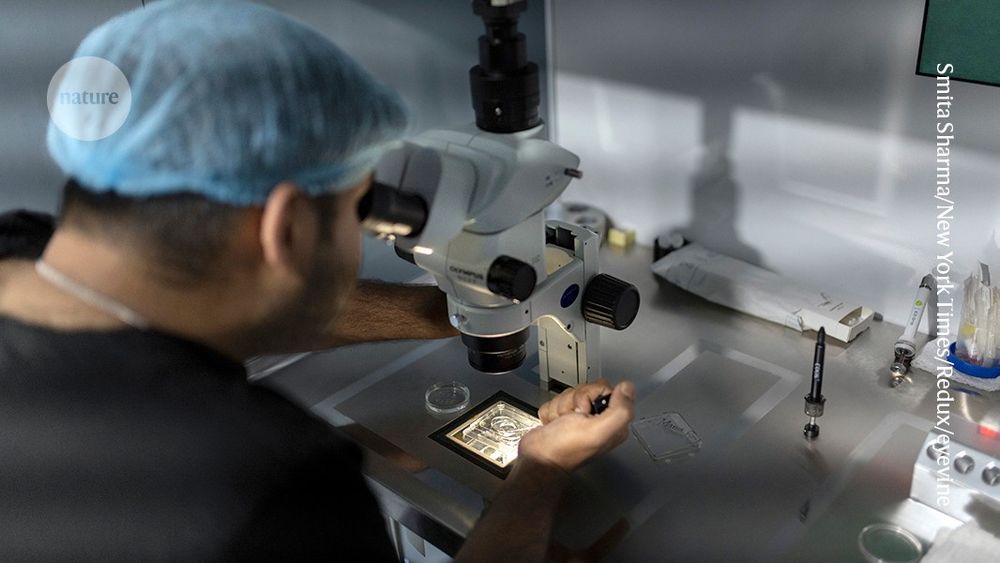
Human embryo research: how to move towards a 28-day limit
The decades-old limit on how long human embryos can be grown in culture is under debate. A new road map outlines how to extend the length of culture responsibly.
go.nature.com
July 1, 2025 at 1:33 PM
The decades-old limit on how long human embryos can be grown in culture is under debate
https://go.nature.com/448yuYw
https://go.nature.com/448yuYw
Reposted by RobertoFeuda
Our new paper is out: "The 3D architecture of the ctenophore aboral organ & the evolution of complex integrative centers in animals.
We reveal a remarkable cell type diversity, nerve net condensation, a multilayered circuit & gene expression profiles.
www.biorxiv.org/content/10.1... #ctenophores
We reveal a remarkable cell type diversity, nerve net condensation, a multilayered circuit & gene expression profiles.
www.biorxiv.org/content/10.1... #ctenophores
June 28, 2025 at 6:55 AM
Our new paper is out: "The 3D architecture of the ctenophore aboral organ & the evolution of complex integrative centers in animals.
We reveal a remarkable cell type diversity, nerve net condensation, a multilayered circuit & gene expression profiles.
www.biorxiv.org/content/10.1... #ctenophores
We reveal a remarkable cell type diversity, nerve net condensation, a multilayered circuit & gene expression profiles.
www.biorxiv.org/content/10.1... #ctenophores

